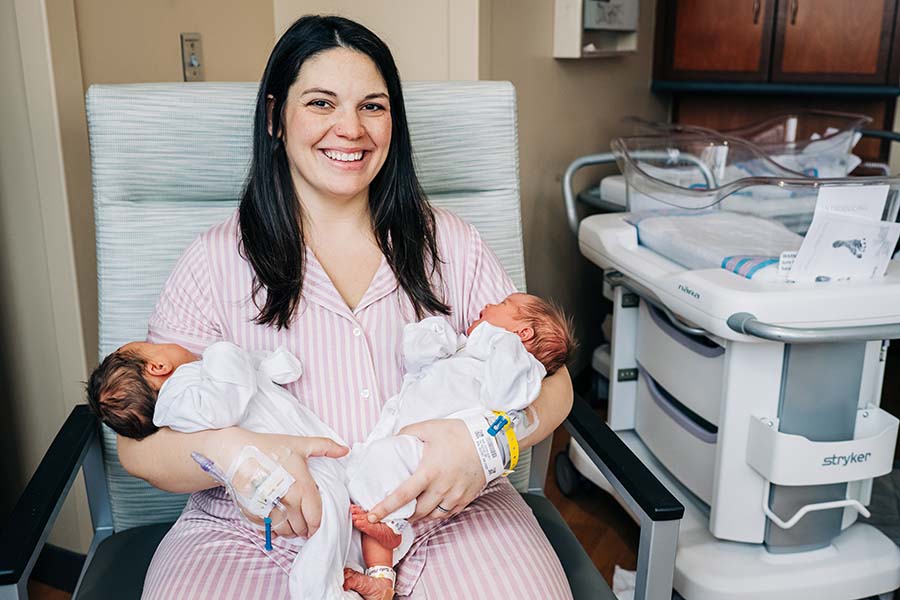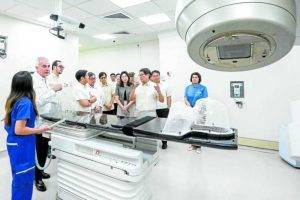Extraordinary Birth in a Woman with Double Uterus: The Dicavitary Twin Pregnancy Case
Kelsey Hatcher’s extraordinary pregnancy journey has culminated in a rare and fascinating birth story. Living with Uterus Didelphys, a condition where two separate uterine cavities exist, Kelsey faced a one-in-a-million dicavitary twin pregnancy.
Each of her daughters developed in a distinct uterus, leading to their births 10 hours apart on different days. Reflecting on this unique experience, Kelsey shared, “Never in our wildest dreams could we have planned a pregnancy and birth like this; but bringing our two healthy baby girls into this world safely was always the goal.” This exceptional case was managed with the utmost care at the University of Alabama at Birmingham Hospital, showcasing the extraordinary capabilities and adaptability of modern obstetrics.
Delving into Uterus Didelphys: Understanding Kelsey’s Condition
Uterus Didelphys, Kelsey Hatcher’s rare condition, is characterised by the presence of two separate uterine cavities, a result of incomplete fusion of the Müllerian ducts during fetal development. This condition, occurring in about 0.3 percent of women, often remains unnoticed until it is revealed by related reproductive issues or during routine medical examinations. In Kelsey’s unique situation, each uterus had its own cervix, and she became pregnant in both uteri simultaneously.
Describing her condition, Kelsey said, “As soon as she moved the wand to the other uterus, I gasped. Sure enough, there was another baby. We just could not believe it.” This diagnosis set the stage for an extraordinary pregnancy and birth journey, highlighting a remarkable aspect of human reproductive variation.
Navigating the Rare Path of Dicavitary Twin Pregnancy
Kelsey Hatcher’s pregnancy was a medical rarity, a true one-in-a-million case of dicavitary twin pregnancy, where each baby developed in a separate uterus. Typically, women with Uterus Didelphys might experience pregnancy in one uterus, as Kelsey did in her three prior pregnancies.
However, having a baby in both uteri simultaneously is extremely rare. Kelsey’s obstetrician at UAB, Dr. Shweta Patel, expressed her astonishment, stating, “I had already taken care of Kelsey through her third pregnancy and knew she had a double uterus, but two babies in two uteri were a true medical surprise.” This unexpected situation required specialised care and presented unique challenges for both Kelsey and her medical team at UAB, illustrating the complex and unpredictable nature of reproductive health.
The Complexities and Planning of a Unique Delivery
The delivery of Kelsey Hatcher’s twins was a meticulously planned event, given the exceptional nature of her dicavitary twin pregnancy. With limited case studies to reference, the medical team at UAB, including Dr. Shweta Patel and maternal-fetal medicine expert Dr. Richard O. Davis, prepared for various potential scenarios. These included the possibility of both babies being born vaginally, one baby being delivered vaginally and the other via caesarean section, or a double caesarean section. Dr. Davis highlighted the uniqueness of the situation: “In a typical twin pregnancy, the twins share one womb… With Kelsey’s babies, they each had their own womb, sac, placenta, and umbilical cord, allowing them extra space to grow and develop.” This careful preparation underscores the importance of adaptability and expert collaboration in managing such rare and complex pregnancies.
A Tale of Two Births: The Staggered Arrival of Dicavitary Twins
Kelsey’s labour and delivery process was unique due to her double uterus. Induced at 39 weeks, she initially had differing cervical dilation in each uterus. The medical team, closely monitoring both babies, decided to focus on the more advanced pregnancy in the right uterus first. Roxi, the baby in the right uterus, was born vaginally.
Dr. Patel described the moment: “There was a cheer from everyone in the room when the first baby was delivered, but there was another baby left.” The challenge continued as Kelsey labored in the left uterus while simultaneously undergoing postpartum processes in the right. Approximately 10 hours later, Rebel, in the left uterus, was delivered via cesarean section. This extraordinary sequence of births exemplifies the complex coordination required in managing such a unique delivery.
Reflections on a Groundbreaking Obstetric Achievement
The successful delivery of Kelsey Hatcher’s twins in a dicavitary twin pregnancy was a groundbreaking achievement for the obstetric team at UAB. It illustrated the unpredictable nature of obstetrics and the necessity for a collaborative, multidisciplinary approach in handling rare and complex cases.
Dr. Patel reflected on this experience, emphasising the importance of teamwork in achieving positive outcomes: “It goes to show that the field of obstetrics is always changing and unpredictable, and you don’t always have clear-cut answers. It takes a team of experts… to take care of such a rare pregnancy.” This case not only adds to the medical literature but also celebrates the capabilities and resilience of both the medical team and the patient in navigating uncharted territories in maternal health.
The birth of Kelsey Hatcher’s babies raises an intriguing question: Are they technically twins? In a typical twin pregnancy, both babies develop in the same uterus. However, in Kelsey’s unique case, each baby developed in a separate uterus, born 10 hours apart. Dr. Richard O. Davis, from UAB, offered his perspective: “I think it is safe to call the girls fraternal twins. At the end of the day, it was two babies in one belly at the same time. They just had different apartments.” This distinction adds an interesting layer to the definition of twins and exemplifies the diverse and remarkable nature of human reproduction.
Image credit: The University of Alabama at Birmingham
References
- Echols, H. (2023, December 22). Double the uterus, double the babies, double the birthdays: Alabama mom delivers rare twins at UAB – News. UAB News. https://www.uab.edu/news/health/item/13917-double-the-uterus-double-the-babies-double-the-birthdays-alabama-mom-delivers-rare-twins-at-uab?fbclid=IwAR3S6YXV1ESI7_qW5uzNQngkCPaRRJ8uCJpfeeMqeMRBGAyv5bSnbmU8rp8














